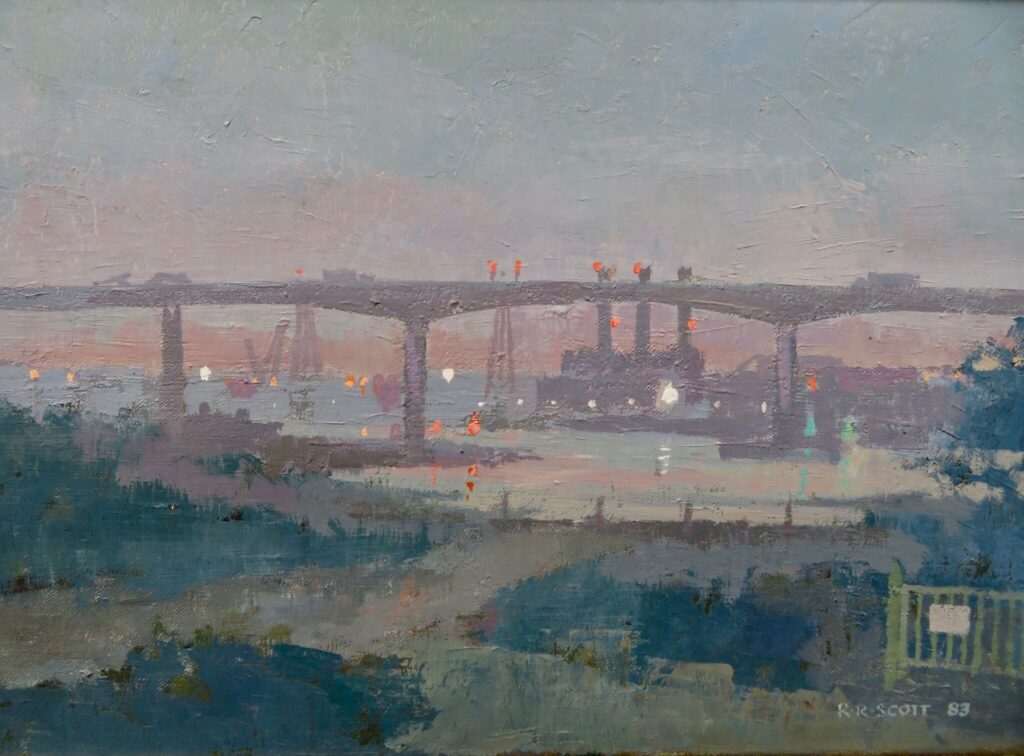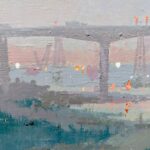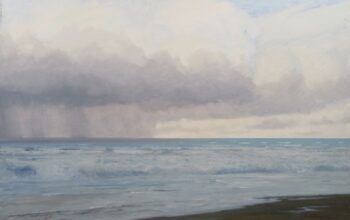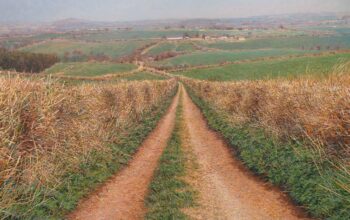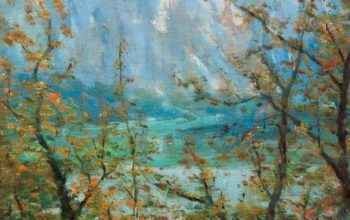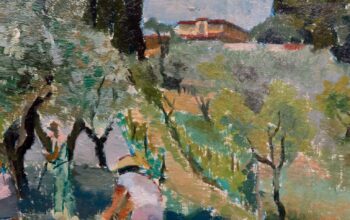Richard Scott
ARTIST: Richard Ridsdale Scott (1938-2020) British
TITLE: “The Orwell Bridge, Ipswich”
SIGNED: lower right
MEDIUM: oil on canvas
SIZE: 45cm x 35cm framed
CONDITION: excellent
PRICE: £sold
DETAIL: Scott sadly died early in 2020, a most talented artists who contributed a great deal to East Anglian art during his long life and artistic career. This work dating to 1983 depicts the Orwell Bridge in Ipswich at dusk with the warm lights of ships and estuary buildings in the distance.
Richard Ridsdale Scott was born on 5th May 1938 in Bromley, where his early memories were dominated by wartime misfortunes, including a direct hit to the family home in a German bombing raid. He attended Bickley Park Preparatory School before being sent to board at Cranbrook School. While this was not his happiest experience, he was able in later life to recall amusing schoolboy anecdotes which he recounted with his native raconteur’s wit. Samphire Cottage was purchased by Richard’s parents, Eric and Marjorie, in 1950, and Walberswick became home. Eric, an accomplished watercolour painter, encouraged his talented only son into a career in art. On leaving school, Richard enrolled at Lowestoft College and from there he moved to Camberwell School of Art to take his National Diploma in Design. National Service came as an unavoidable interruption but, following basic training, Richard was posted to Jamaica for 18 happy months in the Royal Army Educational Corps. Returning to Camberwell to be employed as a technician, Richard met sculpture student Lesley Munkman. They married in July 1962 and lived in Camberwell Grove. Richard embarked on a new career designing and constructing sports cars with two amateurs in a small lock-up in Lulworth Road, Nunhead, before becoming a professional with Diva Cars. This was to remain a lifelong passion. During this period he also shared a sculpture studio with John Ravera in Soho’s Kingly Street. Richard and Lesley moved to Walberswick in 1965 following the birth of the first of their two daughters. Centaur Engineering was established in a workshop in Halesworth where Richard designed and constructed 750-formula racing cars. The workshop building was later demolished for redevelopment, but some Centaur cars are still racing and have won championships as recently as the 2010’s.
As a natural and enthusiastic educator, Richard taught adult evening art classes and residential courses in the area for many years. In 1971 he took up a teaching position in the School of Art & Design at the then Suffolk College, where he lectured until he retired in 1995. His art career took off in earnest following his early retirement.
A founder member and president of The Suffolk Group of artists, Richard painted almost exclusively in oil on small boards. His subject was the local landscape, always including man-made structures but seldom human figures. His paintings favoured the half-light and evocative atmosphere of dusk. He exhibited at the Chappel Galleries in Essex and at numerous mixed exhibitions including the RA Summer Exhibition, the New English Art Club annual exhibition, and the Suffolk Group annual exhibition. Combining his interests in and knowledge of art and local history, Richard contributed chapters to various art history books and wrote The Walberswick Enigma, and the definitive Artists at Walberswick: East Anglian Interludes 1880-2000. He was the leading authority on, and champion of, the Walberswick Scroll, an artistic record of Walberswick painted in the early 1930s by John Doman Turner. Convinced of the historical interest and importance of this unique artefact, he was determined that it should remain intact, preserved, and held in the village for careful public view. He devoted much time and energy to this project as a gift to Walberswick.

